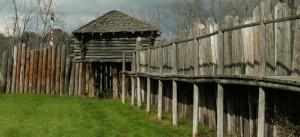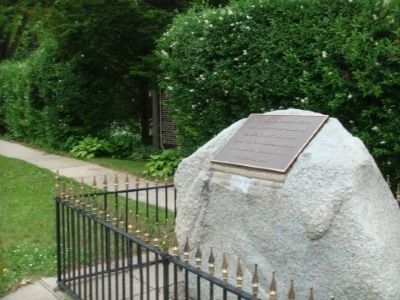
Cause of the Black Hawk War
As the United States was expanding its territory westward across the country, government officials tried to buy as much land from the Native Americans as possible. In 1804 Governor William Henry Harrison negotiated a treaty with the Sauk Indians sold their lands east of the Mississippi to the United States government. The treaty allowed the tribes to continue living on the land until it was sold to American settlers. In 1828, the purchased land was finally sold to American settlers and the tribes were forced to move from their land. By 1829 all of the members of the Sauk tribe had left the purchased land to avoid conflict with American settlers.
In 1831 Sauk and Fox Indians under the command of Black Hawk violated the treaty from 1804 and crossed over the Mississippi River into Illinois. General Henry Atkinson was ordered to remove the Natives from Illinois, and offered them sixty thousand bushels of corn to leave. The Natives took General Atkinson’s offering and retired back across the Mississippi river to their land (Clark 312).
The following summer, the Indians once again crossed the Mississippi river in hope of getting another sixty thousand bushels of corn for free. Due to this second violation of the treaty stipulation of 1804 by the Sauk and Fox Indians under Black Hawk’s command, General Henry Atkinson was once again ordered to remove the Indians from American lands. Instead of repeating the same action from the previous year and meeting the demands of Black Hawk, General Atkinson ordered all available troops to take arms, and the President of the United States ordered Illinois militia to remove the Indians from American lands under the command of General Atkinson. This taking up of arms is what started what is known as the Black Hawk War. General Atkinson and his troops pursued Black Hawk’s army up the Rock River until he reached the junction of the Bark and Rock rivers. At this location, now in the city of present day Fort Atkinson, General Atkinson established his headquarters and his troops constructed a temporary fort for sick troops to rest, to restock on supplies, and to command troop movements during the war. This temporary fort was called Fort Koshkonong (Clark 312-313).
Fort Design and Layout
Due to Fort Koshkonong being a temporary fort for sick troops, and the redeployment of troops, there was never a permanent building constructed inside of the fort, it was only a stockade, a barrier formed from upright wooden posts or stakes. According to Celene Foster, the first white child brought into Fort Koshkonong, “the stockade was constructed of burr oak logs cut in half, the ends of which were set in the ground so as to stand about eight feet high.” Foster also stated that at one point there were approximately 4,500 men stationed at Fort Koshkonong under General Atkinson’s command (Wisconsin Historical Society). In the writing of a Black Hawk War scout Satterlee Carl. the fort was constructed of log pickets, with loop-holes for musketry, with block-houses on the south-east and north-west corners, with about an acre of ground within the enclosure” (Clark 313). In an army report on July 17, 1832 to General Winfield Scott, General Atkinson wrote “Whilst lying here we have thrown up a stockade work flanked by four block houses for the security of our supplies and the accommodation of the sick” (Nichols). Even though the fort never had any permanent buildings, many temporary housing units were set up for soldiers to rest and recover in.
During the Black Hawk War
While General Atkinson’s troops were constructing Fort Koshkonong, General Black Hawk learned from the Winnebago Indians, who promised to assist him, that only around 30 men remained in Fort Winnebago. The commanding Officer at Fort Winnebago concluded that the fort would fall without any reinforcements and sent scout Satterlee Clark to travel to Fort Koshkonong to gain reinforcements from General Atkinson. Upon arriving safely at Fort Koshkonong and delivering his dispatches to General Atkinson, the General sent 3,000 men to relieve Fort Winnebago. Five days after the initial dispatch of the troops, the finally left Fort Winnebago in pursuit of the Indians (Clark 313). Though never under direct attack from the British Band, Fort Koshkonong served as a center to dispatch troops as reinforcements to other nearby forts.
Post Black Hawk War
After the Black Hawk War campaign had ended, the fort was given to friendly Pottawatomie Indians, who had maintained the fort for less than a year before being forced to sell all of their eastern lands and move (Weist). After the Pottawatomie Indians had moved from the fort, Fort Koshkonong became abandoned. In September of 1836 Dwight Foster arrived at what is present day Fort Atkinson, and erected the first log cabin in the area. Many other settlers followed suit, and took advantage of the now abandoned Fort Koshkonong, and used its wood to construct their new homes and buildings. By 1840 almost none of the original fort remained from settlers using the lumber from the fort.

In 1907 The Fort Atkinson Daughters of The American Revolution built a monument in the original location of Fort Koshkonong (Toman). A complete reconstruction of the fort was built in Rock River Park in 1966 as another memorial to the fort (Wisconsin Historical Society).
Primary Sources
1. Clark, Satterlee and Lyman C Draper. “Early Times at Fort Winnebago.” Collections of the State Historical Society of Wisconsin, vol. 8, Wisconsin Historical Society, 1908, pp. 309–321.
2. Nichols, Roger L. General Henry Atkinson: a Western military career. University of Oklahoma Press., 1965.
3. Wisconsin Historical Society. Wisconsin Local History & Biography Articles; “Janesville Gazette”; “Fort Atkinson”, “WI”; “January 7, 1933”; viewed online at https://www.wisconsinhistory.org on [October 19, 2017]
Secondary Sources
1. Toman, William J. “Fort Koshkonong Historical Marker.” The Historical Marker Database, 16 June 2016, www.hmdb.org/marker.asp?marker=31765.
2. Weist, Timothy J, and William S Powell. “Atkinson, Henry.” Dictionary of North Carolina Biography, vol. 6, University of North Carolina Press, 1979.
